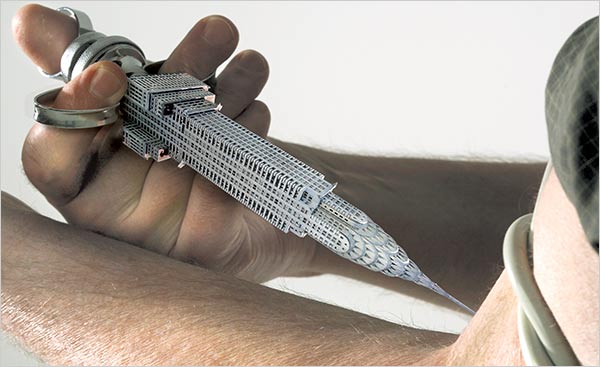American journalism’s vaunted self-image as a watchdog apparently stops at the curb of Wall Street. Instead of investigative journalism, the public is fed executive hagiographies and paeans to entrepreneurship and productivity. Even after the downward spiral of the last few months, the analysis often is devoted too much to praising the intelligence of the players and the complexity of the deals. The accompanying photos of gilded office towers and middle-aged guys in sharp clothes hardly diminishes the luster of those supposedly being scrutinized. And then, in a single stroke, an image appeared this weekend that stabbed through to the truth.
The image accompanied a New York Times article in the Sunday Business section of the paper on “How Lehman Got Its Real Estate Fix.” The title and this stunning photo illustration are the only suggestions of addiction in the paper. By contrast, in the article we learn of the keen intelligence and deeply reflective character of Mark Walsh, the financier who “pioneered” the practice of repackaging real estate debt to produce huge short term profits–and a massive backlog of toxic debt. But read all you want, as long as you look at the image and the truth exposed by its visual artistry.
Drug addicts can be smart, real smart, and also well educated and highly creative. They’re still addicts. A culture that is based on addiction can be dazzling and also incredibly destructive. The rest of the world is now waking up to the fact that we’ve been living with unchecked addiction, and the savings account has been looted, the future mortgaged, and trust destroyed.
And finally someone said so. The image doesn’t speak directly, of course, but a statement has been made. The image manipulates available iconography and our sense of scale to create a powerful sense of dislocation and abuse. How could that building be there? Well, how could trillions of dollars in wealth be shrunk to next to nothing, isn’t the entire debacle about losing any reasonable sense of proportion, any sense of natural limit or appropriate restraint? Why the Chrysler building? Well, wasn’t the damage done by some of the classiest firms on the Street, and weren’t they willing to use anything–anything–to feed their habit? And shooting up? Well, they were tough guys willing to take any risk, right?
If the image is scandalous, it is because that is what is needed to expose a culture of enabling and denial. Think about it. You don’t deal with addiction effectively by taking away the drug–or by giving the addict money and another chance at self-regulation. The life of the individual and of the family has to be re-examined and restructured to some positive end. The artists at the Times have revealed the true nature of the problem. That’s as much as they can do. Now we need to see if the current administration is willing to admit to what is wrong, and what needs to be done.
Photo illustration by the New York Times, May 3, 2009. Cross posted at BAGnewsNotes.

Why the Chrysler Building? Because it’s the pointiest building in New York. That’s probably too simple and straightforward for you, but imagine trying to shoot up wth the Seagram Building or any of the other boxes.
The rest of the piece is just too silly for words.